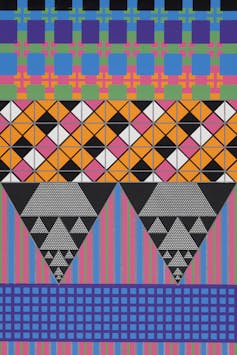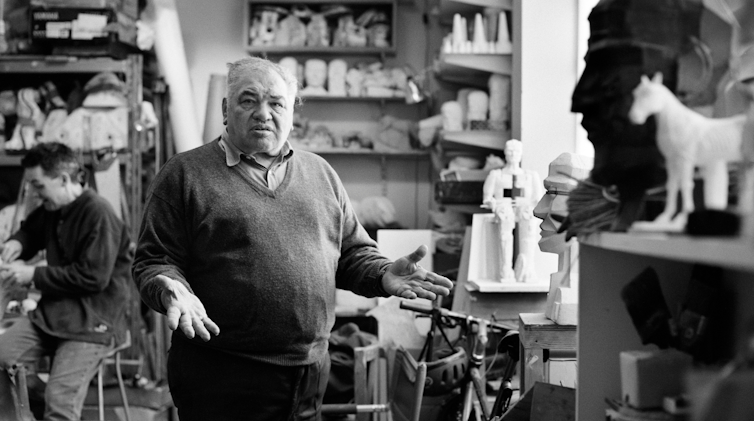Celebrating 100 years since the birth of Scottish pop artist Sir Eduardo Paolozzi, a new exhibition at Edinburgh’s National Galleries Scotland explores some of the artist’s most popular works.
Eduardo Paolozzi (1927-2005) was a prolific artist most known for his hulking surrealist sculptures. However, his work crossed a range of creative styles including paper collage, lithography, silk screen, textiles, murals and ceramics. Paolozzi’s influence on the 20th century artworld was immense and he helped shape several art movements with his unique insights.
The exhibition features over 60 pieces of work set out over two gallery spaces. Paolozzi’s obsessive creativity is there to be seen in all forms of its glory. From his early paper collage work, inspired by the surrealist style of Kurt Schwitters and Max Ernst, to his seminal involvement with the pop art movement. The exhibition highlights how Paolozzi was clearly a man ahead of his time.
Paolozzi was born in Edinburgh’s Leith port neighbourhood to Italian immigrants in 1924. At the age of 16 his life changed dramatically when nearly 400 of the city’s Italian Scots, including him, were rounded up and sent to internment camps under Winston Churchill’s order to “collar the lot” (the lot being “enemy aliens”, including Italians, Germans and Jewish people).
His career as an artist began in post-second world war Edinburgh where he attended evening classes at Edinburgh College of Art. He later enrolled at Slade School of Art in London. It was in the mid-1940s that Paolozzi began his love affair with collage, using images from magazine and books.
He held his first exhibition of drawings and sculptures in 1947 while still an undergraduate. The success of this exhibition enabled him to move to Paris. It is here where he would develop an interest in surrealism, which would pave the way for his distinct pop art style, which mixed collage and printmaking.
For this work Paolozzi is considered an early pioneer of pop art and is often called the father of British pop art. This exhibition is a testament to the breadth of his work and a true celebration of one of Britain’s greatest artists.
Paolozzi the pop artist
Paolozzi was appointed as a teacher at the Central School of Arts and Crafts from 1950 to 1955. At this time, he became a founding member of the Independent Group. This was a radical group of young artists, writers and architects who challenged the dominant modernist culture of the time.
The modernists (including movements like cubism and post-impressionism) championed abstraction – line, form and colour were important to them. The Independent Group found this way of undermining elitism and challenged it with work that focused on the impact of popular culture.
Debra Hurford Brown/National Galleries Scotland
This approach can be seen in one the show’s highlights, the “tear sheets” in Take-off, one of the original 45 collages from his Bunk Pop Art series. These collages feature advertising imagery of popular cultural icons, sex symbols and consumer goods.
These were shown without any description at a presentation of popular culture that Paolozzi gave at London’s Institute of Contemporary Art in 1952 and were met by a bemused, unimpressed avant-garde and intellectual audience.
However, this is the sort of work that would become popular. There is an ongoing debate about whether these collages were the first truly pop art works or simply pieces in Paolozzi’s many scrapbooks that were categorised after the pop art movement had been defined. Nevertheless, Paolozzi’s obsession with commercial images foregrounded the cultural movement of post-war consumerism and advertising at the time and influenced how artists responded to it.
Silk screen printing as a new art form
Paolozzi’s exploration and use of silk screen print making techniques as an art form was ahead of other contemporary artists such as Andy Warhol, who latterly was exhibited beside him at the Museum of Modern Art in New York (1968). He is said to have revolutionised the medium by translating his collage style to printing.

Trustees of the Paolozzi Foundation. Licensed by
DACS, London 2023
One of the most striking examples of his silk screen work in the exhibition is As is When (1965). Part of a series of 12 pattern screen prints, the designs have elements of abstract expressionism and op art patterns within them, utilising geometric forms to create optical effects. Paolozzi exploits the unique colour separation properties of silk screen printing and includes quotes from the Viennese philosopher Ludwig Wittgenstein’s writing.
Another piece that highlights his ingenuity in print making is Moonstrips Empire News (1967), which was created as a portfolio of 100 loose-leaf screen prints. In true Paolozzi style, these prints used all sorts of source material including cartoon characters, abstract patterns of circles and lines together with collaged texts packaged together.
This exhibition highlights the amazing talent of this artist and the incredible breadth and scope of his creative life. It’s an impressive show that will certainly increase visitor’s appreciation for this great Scottish artist.

Looking for something good? Cut through the noise with a carefully curated selection of the latest releases, live events and exhibitions, straight to your inbox every fortnight, on Fridays. Sign up here.




